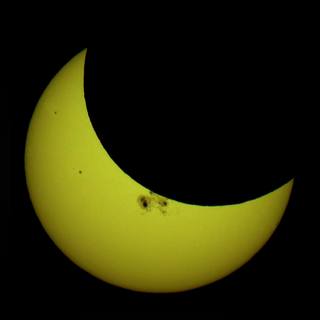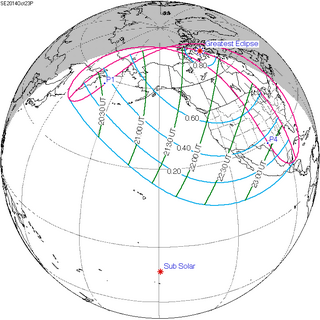Solar eclipse of October 23, 2014
| Solar eclipse of October 23, 2014 | |
|---|---|
 From Minneapolis, near greatest eclipse | |
| Type of eclipse | |
| Nature | Partial |
| Gamma | 1.0908 |
| Magnitude | 0.8114 |
| Maximum eclipse | |
| Coordinates | 71°12′N 97°12′W / 71.2°N 97.2°W |
| Times (UTC) | |
| (P1) Partial begin | 19:37:30 |
| Greatest eclipse | 21:45:39 |
| (P4) Partial end | 23:51:36 |
| References | |
| Saros | 153 (9 of 70) |
| Catalog # (SE5000) | 9540 |
A partial solar eclipse occurred on October 23, 2014. A solar eclipse occurs when the Moon passes between Earth and the Sun, thereby totally or partly obscuring the image of the Sun for a viewer on Earth. A partial solar eclipse occurs in the polar regions of the Earth when the center of the Moon's shadow misses the Earth.
Viewing
The center of the Moon's shadow missed the Earth, passing above the North Pole, but a partial eclipse was visible at sunrise (October 24 local time) in far eastern Russia, and before sunset (October 23) across most of North America.
 Animated path |
Visibility
The partial eclipse was visible in most of North America, as well as eastern Siberia.
Gallery
-
Simulated greatest partiality from Nunavut, Canada at sunset
-
Minneapolis, 21:34 UTC. The eclipse coincided with giant sunspot region 2192, the largest seen in 24 years.[1]
-
San Jose, California, 21:34 UTC
-
Superior National Forest, 21:42 UTC
-
Joshua Tree National Park, 21:43 UTC
-
Joshua Tree National Park, 22:14 UTC
-
Mentor, Ohio, 22:19 UTC
-
College of DuPage, 22:28 UTC
-
Mountain View, California, 22:33 UTC
-
Minneapolis, 22:35 UTC
-
Melbourne, Florida, 22:38 UTC
-
Denver, Colorado, 22:40 UTC
-
Cupertino, California, 22:47 UTC
-
Telescopic projection of the eclipse in Cupertino, California
-
Minneapolis at sunset, 22:54 UTC
-
Coralville, Iowa at sunset, 22:56 UTC
-
Van Nuys, California, 23:06 UTC
-
Time lapsed image from Melbourne, Florida
-
Composite image from Minneapolis
Related eclipses
Solar eclipses 2011–2014
This eclipse is a member of a semester series. An eclipse in a semester series of solar eclipses repeats approximately every 177 days and 4 hours (a semester) at alternating nodes of the Moon's orbit.[2]
The partial solar eclipses on January 4, 2011 and July 1, 2011 occur in the previous lunar year eclipse set.
| Solar eclipse series sets from 2011 to 2014 | ||||||
|---|---|---|---|---|---|---|
| Descending node | Ascending node | |||||
| Saros | Map | Gamma | Saros | Map | Gamma | |
118 Partial in Tromsø, Norway |
June 1, 2011 Partial |
1.21300 | 123 Hinode XRT footage |
November 25, 2011 Partial |
−1.05359 | |
128 Annularity in Red Bluff, CA, USA |
May 20, 2012 Annular |
0.48279 | 133 Totality in Mount Carbine, Queensland, Australia |
November 13, 2012 Total |
−0.37189 | |
138 Annularity in Churchills Head, Australia |
May 10, 2013 Annular |
−0.26937 | 143 Partial in Libreville, Gabon |
November 3, 2013 Hybrid |
0.32715 | |
148 Partial in Adelaide, Australia |
April 29, 2014 Annular (non-central) |
−0.99996 | 153 Partial in Minneapolis, MN, USA |
October 23, 2014 Partial |
1.09078 | |
Metonic series
The metonic series repeats eclipses every 19 years (6939.69 days), lasting about 5 cycles. Eclipses occur in nearly the same calendar date. In addition, the octon subseries repeats 1/5 of that or every 3.8 years (1387.94 days). All eclipses in this table occur at the Moon's ascending node.
| 22 eclipse events between January 5, 1935 and August 11, 2018 | ||||
|---|---|---|---|---|
| January 4–5 | October 23–24 | August 10–12 | May 30–31 | March 18–19 |
| 111 | 113 | 115 | 117 | 119 |
 January 5, 1935 |
 August 12, 1942 |
 May 30, 1946 |
 March 18, 1950 | |
| 121 | 123 | 125 | 127 | 129 |
 January 5, 1954 |
 October 23, 1957 |
 August 11, 1961 |
 May 30, 1965 |
 March 18, 1969 |
| 131 | 133 | 135 | 137 | 139 |
 January 4, 1973 |
 October 23, 1976 |
 August 10, 1980 |
 May 30, 1984 |
 March 18, 1988 |
| 141 | 143 | 145 | 147 | 149 |
 January 4, 1992 |
 October 24, 1995 |
 August 11, 1999 |
 May 31, 2003 |
 March 19, 2007 |
| 151 | 153 | 155 | ||
 January 4, 2011 |
 October 23, 2014 |
 August 11, 2018 | ||
Notes
References
- ^ "Gentle giant sunspot region 2192".
- ^ van Gent, R.H. "Solar- and Lunar-Eclipse Predictions from Antiquity to the Present". A Catalogue of Eclipse Cycles. Utrecht University. Retrieved 6 October 2018.
External links
- Earth visibility chart and eclipse statistics Eclipse Predictions by Fred Espenak, NASA/GSFC
- Partial Solar Eclipse 23 October 2014 from start to maximum on YouTube
- Nontechnical information at NASA SSERVI
- Sunspots and Solar Eclipse APOD 10/25/2014



![Minneapolis, 21:34 UTC. The eclipse coincided with giant sunspot region 2192, the largest seen in 24 years.[1]](http://upload.wikimedia.org/wikipedia/commons/thumb/8/81/Solar_eclipse_of_October_23_2014_start_of_partial.jpg/120px-Solar_eclipse_of_October_23_2014_start_of_partial.jpg)



















